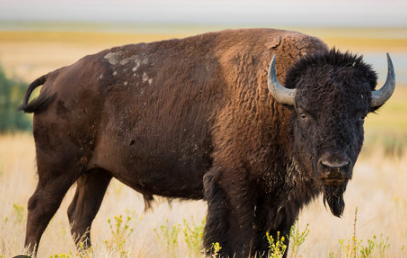Nestled in the plains of McPherson County is what many have described Kansas’ best-kept secret of an attraction and home to more than 200 bison.
Driving into Maxwell Wildlife Refuge, six miles north of Canton, people may be greeted by one of these bison on the road, but there’s not much tame about these animals and the “wild” of wildlife means people shouldn’t get too close.
Fortunately because of a group of dedicated volunteers, people have access to get fairly up close, in a safe way, to these living symbols of Kansas and national mammals of the United States.
The Friends of Maxwell have been operating guided tours on open air trams, since the 1990s with the assistance of Kansas Department of Wildlife and Parks, which oversees the state-owned land.
How did the Maxwell Wildlife Refuge come about?
The refuge has history dating back to 1859, when John Maxwell, a Scottish immigrant settled in McPherson County as a homesteader.
After falling in love with the animals of the prairies in the area, Maxwell decided he wanted to make sure people in the future had an opportunity to see this area for what it is.
“In 1859, hardly any of these trees were here,” said Les Sporting, one of the narrators of the tram tour. “The grass was 7 feet tall, there were no fences and there were bison, elk, deer, wolves and a host of other animals.”
Maxwell ended up leaving $75,000 in his estate, estimated to be nearly $3 million in today’s economy, with the purpose of buying land and keeping animals on it for the future.
“In 1944, his two sons bought four square miles of native grass … and deeded it to the state of Kansas,” Sporting said.
After building an 8-foot tall fence, which took nearly seven years to complete, the refuge brought 10 bison and six elk onto the land in the early 1950s.
“We got the bison logically from exactly where you’d think we would, the Bronx Zoo in New York City,” he said. “From those meager beginnings, we now have the largest publicly owned (bison) herd in the state of Kansas with a winter herd size of 190.”
Sporting said that herd grows beginning in April or May as bison calves, are born, and as of July, the herd was around 260 to 270 strong.
In November of each year, the herd size is reduced, as some of the bison are sold off in a public auction to people adding to their own herds or for meat.
What can visitors expect to see on a Maxwell tram tour?
Bison can grow to more than 6-feet tall, weigh as much as 2,000 pounds, run 35 to 45 mph and leap as high as six feet, so Maxwell makes sure to keep visitors safe inside these trams.
“This is the time of the year that breeding season starts, so I ask you to please remain in you seat and under no circumstances put your hands outside the tram because these animals can get a little frisky,” Sporting said.
With 2,254 acres of land for the bison to roam, feeding trucks go ahead of the tram with some incentive, little treats placed near the path of the trams.
Along the path, visitors can expect to see bison bulls, cows and calves, or red dogs as they are called due to their reddish fur in the early stages of life.
These bison will get next to and against the tram, allowing some of the closest encounters someone will ever get to these massive mammals.
During some parts of the year, visitors can also expect to see elk, though, unlike bison, elk don’t do well in warmer temperatures and will tend to hide out in shade during sunny summer days.
Finally, people can also see upward of 40 species of wild flowers and witness what the beauty of the mixed grass prairie that most of Kansas is known for.
When and how much are Maxwell Wildlife Refuge tours?
While the refuge itself is open to the public, with access and through traffic via Pueblo Road, there is no guarantee this “free” drive will let people see bison or other wildlife.
That’s what makes these tours a unique opportunity.
Right now, tours are offered at 10 a.m. Tuesdays and Saturdays, with private tours also available by reaching out to the Friends.
Tram tour tickets are $15 for ages 12 and older, $7.50 for children ages 4 to 11 and free for children under the age of three. All children must be accompanied by an adult.
For more information or to buy tickets, visit the Friends of Maxwell website, maxwellwildliferefuge.com.
As reported in the Salina Journal




